Colour Stabilization of Oak, Spruce, Larch and Douglas Fir Heartwood Treated with Mixtures of Nanoparticle Dispersions and UV-Stabilizers after Exposure to UV and VIS-Radiation
Abstract
1. Introduction
2. Material and Methods
2.1. Wood Samples
2.2. Surface Treatments
2.3. Accelerated Ageing
2.4. Microscopic and Elemental Composition Analyses
2.5. Colour Analyses
- ∆EAP*—The total colour difference after surface treatment application
- ∆E50*—Change in the original colour after 50 h of artificial ageing (due to the original colour of the wood without surface treatment)
- ∆E160*—Change in the original colour after 160 h of artificial ageing (due to the original colour of the wood without surface treatment)
- ∆E320*—Change in the original colour after 320 h of artificial ageing (due to the original colour of the wood without surface treatment)
2.6. Roughness Measurements
2.7. Statistical Analyses
3. Results and Discussion
3.1. Colour Changes
3.2. Changes of Surface Roughness
3.3. Final Discussion
4. Conclusions
Author Contributions
Funding
Acknowledgments
Conflicts of Interest
References
- Evans, P.D.; Haase, J.G.; Shakri, A.; Seman, B.M.; Kiguchi, M. The search for durable exterior clear coatings for wood. Coatings 2015, 5, 830–864. [Google Scholar] [CrossRef]
- Cogulet, A.; Blanchet, P.; Landry, V. The multifactorial aspect of wood weathering: A review based on a holistic approach of wood degradation protected by clear coating. BioResources 2018, 13, 2116–2138. [Google Scholar] [CrossRef]
- Rosu, D.; Rosu, L.; Cascaval, C.N. IR-change and yellowing of polyurethane as a result of UV irradiation. Polym. Degrad. Stab. 2009, 94, 591–596. [Google Scholar] [CrossRef]
- Pánek, M.; Reinprecht, L. Colour stability and surface defects of naturally aged wood treated with transparent paints for exterior constructions. Wood Res. 2014, 59, 421–430. [Google Scholar]
- Oltean, L.; Teischinger, A.; Hansmann, C. Wood surface discolouration due to simulated indoor sunlight exposure. Holz Roh Werkst. 2008, 66, 51–56. [Google Scholar] [CrossRef]
- Gobakenn, L.R.; Westin, M. Surface moulds growth on five modified wood substrates coated with three different coating systems when exposed outdoors. Int. Biodeterior. Biodegrad. 2008, 62, 397–402. [Google Scholar] [CrossRef]
- Volkmer, T.; Arietano, L.; Plummer, C.; Strautmann, J.; Noel, M. Loss of tensile strength in cellulose tissue on the surface of spruce (Picea abies) caused by natural photodegradation and delignification. Polym. Degrad. Stab. 2013, 98, 1118–1125. [Google Scholar] [CrossRef]
- Ikei, H.; Song, C.; Miyazaki, Y. Physiological effects of wood on humans: A review. J. Wood Sci. 2017, 63. [Google Scholar] [CrossRef]
- European Committee for Standardization. (EN) 335:2013 Durability of Wood and Wood-Based Products—Use Classes: Definitions, Application to Solid Wood and Wood-Based Products; European Committee for Standardization: Brussels, Belgium, 2013. [Google Scholar]
- George, B.; Suttie, E.; Merlin, A.; Deglise, X. Photodegradation and photostabilisation of wood—The state of the art. Polym. Degrad. Stab. 2005, 88, 268–274. [Google Scholar] [CrossRef]
- Feist, W.C.; Hon, D.N.S. Chemistry of weathering and protection. In The Chemistry of Solid Wood; Rowell, R.M., Ed.; Advances in Chemistry Series 207; American Chemical Society’s: Washington, DC, USA, 1984; pp. 401–451. [Google Scholar]
- Gobakken, L.R.; Lebow, P.K. Modelling mould growth on coated modified and unmodified wood substrates exposed outdoors. Wood Sci. Technol. 2010, 44, 315–333. [Google Scholar] [CrossRef]
- Kržišnik, D.; Lesar, B.; Thaler, N.; Humar, M. Influence of natural and artificial weathering on the colour change of different wood and wood-based materials. Forests 2018, 9, 488. [Google Scholar] [CrossRef]
- Anderson, E.L.; Pawlak, Z.; Owen, N.L.; Feist, W.C. Infrared studies of wood weathering. Part I: Softwoods. Appl. Spectrosc. 1991, 45, 641–647. [Google Scholar] [CrossRef]
- Shenoy, M.A.; Marathe, Y.D. Studies on synergistic effect of UV absorbers and hindered amine light stabilizers. Pigment Resin Technol. 2007, 36, 83–89. [Google Scholar] [CrossRef]
- Scrinzi, E.; Rossi, S.; Deflorian, F.; Zanella, C. Evaluation of aesthetic durability of waterborne polyurethane coatings applied on wood for interior applications. Prog. Org. Coat. 2011, 72, 81–87. [Google Scholar] [CrossRef]
- Moya, R.; Rodríguez-Zúñiga, A.; Vega-Baudrit, J.; Puente-Urbina, A. Effects of adding TiO2 nanoparticles to a water-based varnish for wood applied to nine tropical woods of Costa Rica exposed to natural and accelerated weathering. J. Coat. Technol. Res. 2016, 14, 141–152. [Google Scholar] [CrossRef]
- Reinprecht, L.; Pánek, M. Effects of wood roughness, light pigments, and water repellent on the color stability of painted spruce subjected to natural and accelerated weathering. BioResources 2015, 10, 7203–7219. [Google Scholar] [CrossRef]
- Hill, C.A.S. Wood Modification—Chemical, Thermal and Other Processes; John Wiley and Sons Ltd.: Chichester, UK, 2006; p. 239. ISBN 978-0-470-02172-9. [Google Scholar]
- Passauer, L.; Prieto, J.; Müller, M.; Rössler, M.; Schubert, J.; Beyer, M. Novel color stabilization concepts for decorative surfaces of native dark wood and thermally modified timber. Prog. Org. Coat. 2015, 89, 314–322. [Google Scholar] [CrossRef]
- Pánek, M.; Oberhofnerová, E.; Zeidler, A.; Šedivka, P. Efficacy of hydrophobic coatings in protecting oak wood surfaces during accelerated weathering. Coatings 2017, 7, 172. [Google Scholar] [CrossRef]
- Kutnik, M.; Montibus, M.; Derocker, S.; Salivati, S.; Lecomte, J.P. Assesment of the biological durability of wood treated with organosilicon compounds, In Proceedings of the The International Research Group on Wood Protection, Lisbon, Portugal, 15–19 May 2016; IRG/WP 16-30685, 15p.
- Chou, P.L.; Chang, H.T.; Yeh, T.F.; Chang, S.T. Characterizing the conservation effect of clear coatings on photodegradation of wood. Bioresour. Technol. 2008, 99, 1073–1079. [Google Scholar] [CrossRef] [PubMed]
- Šimůnková, K.; Pánek, M.; Zeidler, A. Comparison of selected properties of shellac varnish for restoration and polyurethane varnish for reconstruction of historical artefacts. Coatings 2018, 8, 119. [Google Scholar] [CrossRef]
- Schaller, C.; Rogez, D. Defended from the sun. Eur. Coat. J. 2006, 12, 22–27. [Google Scholar]
- Forsthuber, B.; Grüll, G. The effects of HALS in the prevention of photodegradation of acrylic clear topcoats and wooden surfaces. Polym. Degrad. Stab. 2010, 95, 746–755. [Google Scholar] [CrossRef]
- Nair, S.; Giridhar, B.N.; Pandey, K.K. UV stabilization of wood by nano metal oxides dispersed in propylene glycol. J. Photochem. Photobiol. B 2018, 183, 1–10. [Google Scholar] [CrossRef] [PubMed]
- Dawson, B.S.W.; Singh, A.P.; Kroese, H.W.; Schwitzer, M.A.; Gallagher, S. Enhancing exterior performance of clear coatings through photostabilization of wood. Part 2: Coating and weathering performance. J. Coat. Technol. Res. 2008, 5, 207–219. [Google Scholar] [CrossRef]
- Tolvaj, L.; Faix, O. Artifical ageing of wood monitored by DRIFT spectroscopy and CIE L* a* b* color measurements. I. Effect of UV light. Holzforschung 1995, 49, 397–404. [Google Scholar] [CrossRef]
- Pandey, K.K. A study of chemical structure of soft and hardwood and wood polymers by FTIR spectroscopy. J. Appl. Polym. Sci. 1999, 71, 1969–1975. [Google Scholar] [CrossRef]
- Müller, U.; Ratzsch, M.; Schwanninger, M.; Steiner, M.; Zobl, H. Yellowing and IR-changes of spruce wood as result of UV-irradiation. J. Photochem. Photobiol. B 2003, 69, 97–105. [Google Scholar] [CrossRef]
- Liu, Y.; Shao, L.; Gao, J.; Guo, H.; Chen, Y.; Cheng, Q.; Via, B.K. Surface photo-discoloration and degradation of dyed wood veneer exposed to different wavelengths of artificial light. Appl. Surf. Sci. 2015, 331, 353–361. [Google Scholar] [CrossRef]
- Aloui, F.; Ahajji, A.; Irmouli, Y.; George, B.; Charrier, B.; Merlin, A. Inorganic UV absorbers for the photostabilisation of wood-clearcoating systems: Comparison with organic UV absorbers. Appl. Surf. Sci. 2007, 253, 3737–3745. [Google Scholar] [CrossRef]
- Cristea, M.V.; Riedl, B.; Blanchet, P. Effect of addition of nanosized UV absorbers on the physico-mechanical and thermal properties of an exterior waterborne stain for wood. Prog. Org. Coat. 2011, 72, 755–762. [Google Scholar] [CrossRef]
- Forsthuber, B.; Müller, U.; Teischinger, A.; Grüll, G. Chemical and mechanical changes during photooxidation of an acrylic clear wood coat and its prevention using UV absorber and micronized TiO2. Polym. Degrad. Stab. 2013, 98, 1329–1338. [Google Scholar] [CrossRef]
- Fufa, S.M.; Jelle, B.P.; Hoyde, P.J. Effects of TiO2 and clay nanoparticles loading on weathering performance of coated wood. Prog. Org. Coat. 2013, 76, 1425–1429. [Google Scholar] [CrossRef]
- Nikolic, M.; Lawther, J.M.; Sanadi, A.R. Use of nanofillers in wood coatings: A scientific review. J. Coat. Technol. Res. 2015, 12, 445–461. [Google Scholar] [CrossRef]
- Forsthuber, B.; Schaller, C.; Grüll, G. Evaluation of the photo stabilising efficiency of clear coatings comprising organic UV absorbers and mineral UV screeners on wood surfaces. Wood Sci. Technol. 2013, 2, 281–297. [Google Scholar] [CrossRef]
- Teacà, C.A.; Rosu, D.; Bodîrlàu, R.; Rosu, L. Structural changes in wood under artificial UV light irradiation by FTIR spectroscopy and color measurements—A brief review. BioResources 2013, 8, 1478–1507. [Google Scholar] [CrossRef]
- Kiguchi, M.; Evans, P.D. Photostabilisation of wood surfaces using a grafted benzophenone UV absorber. Polym. Degrad. Stab. 1998, 61, 33–45. [Google Scholar] [CrossRef]
- Chang, S.T.; Wang, S.Y.; Su, Y.C. Retention of red color in Taiwania (Taiwania cryptomeriodes Hay.) heartwood. Holzforschung 1998, 52, 13–17. [Google Scholar] [CrossRef]
- Schaller, C.; Rogez, D. New approaches in wood coating stabilization. J. Coat. Technol. Res. 2007, 4, 401–409. [Google Scholar] [CrossRef]
- Clausen, C.A.; Green, F.; Kartal, S.N. Weatherability and leach resistence of wood impregnated with nano-zinc oxide. Nanoscale Res. Lett. 2010, 5, 1464–1467. [Google Scholar] [CrossRef] [PubMed]
- Sahin, H.T.; Mantanis, G.I. Colour changes of wood surfaces modified by a nanoparticulate based treatment. Wood Res. 2011, 56, 525–532. [Google Scholar]
- Mishra, P.K.; Giagli, K.; Tsalagkas, D.; Mishra, H.; Talegaonkar, S.; Gryc, V.; Wimmer, R. Changing face of wood science in modern era: Contribution of nanotechnology. Recent Pat. Nanotechnol. 2018, 12, 13–21. [Google Scholar] [CrossRef] [PubMed]
- Kataoka, Y.; Kiguchi, M.; Williams, R.S.; Evans, P.D. Violet light causes photodegradation of wood beyond the zone affected by ultraviolet radiation. Holzforschung 2007, 61, 23–27. [Google Scholar] [CrossRef]
- Olsson, S. Enhancing UV Protection of Clear Coated Exterior Wood by Reactive UV Absorber and Epoxy Functional Vegetable Oil. Ph.D. Thesis, KTH Royal Institute of Technology, Stockholm, Sweden, December 2014. [Google Scholar]
- Salla, J.; Pandey, K.K.; Srinivas, K. Improvement of UV resistance of wood surfaces by using ZnO nanoparticles. Polym. Degrad. Stab. 2012, 97, 592–596. [Google Scholar]
- Tuong, V.M.; Chu, T.V. Improvement of Colour Stability of Acacia hybrid Wood by TiO2 nano sol impregnation. BioResources 2015, 10, 5417–5425. [Google Scholar] [CrossRef]
- Auclair, N.; Riedl, B.; Blanchard, V.; Blanchet, P. Improvement of photoprotection of wood coatings by using inorganic nanoparticles as ultraviolet absorbers. For. Prod. J. 2011, 61, 20–27. [Google Scholar] [CrossRef]
- Gao, H.; Liang, D.X.; Li, J.; Pang, G.S.; Fang, Z.X. Preparation and properties of nano TiO2-ZnO binary collaborative wood. Chem. J. Chin. Univ. 2016, 37, 1075–1081. (In Chinese) [Google Scholar] [CrossRef]
- Wagenführ, R. Holzatlas; Fachbuchverlag: Leipzig, Germany, 2007; p. 816. ISBN 3446406492. [Google Scholar]
- Yalcin, M.; Pelit, H.; Akcay, C.; Cakicier, N. Surface properties of tannin-impregnated and varnished beech wood after exposure to accelerated weathering. Color. Technol. 2017, 133, 334–340. [Google Scholar] [CrossRef]
- Zahri, S.; Belloncle, C.; Charrier, F.; Pardon, P.; Quideau, S.; Charrier, B. UV light impact on ellagitannins and wood surface colour of European oak (Quercus petraea and Quercus robur). Appl. Surf. Sci. 2007, 253, 4985–4989. [Google Scholar] [CrossRef]
- Timar, M.C.; Varodi, A.M.; Gurau, L. Comparative study of photodegradation of six wood species after short-time UV exposure. Wood Sci. Technol. 2016, 50, 135–163. [Google Scholar] [CrossRef]
- Robinson, S.C.; Tudor, D.; Mansourian, Y.; Cooper, P.A. The effects of several commercial wood coatings on the deterioration of biological pigments in wood exposed to UV light. Wood Sci. Technol. 2013, 47, 457–466. [Google Scholar] [CrossRef]
- De Windt, I.; Van den Bulcke, J.; Wuijtens, I.; Coppens, H.; Van Acker, J. Outdoor weathering performance parameters of exterior wood coating systems on tropical hardwood substrates. Eur. J. Wood Wood Prod. 2014, 72, 261–272. [Google Scholar] [CrossRef]
- European Committee for Standardization. (EN) 350: 2016 Durability of Wood and Wood-Based Products—Testing and Classification of the Durability to Biological Agents of Wood and Wood-Based Materials; European Committee for Standardization: Brussels, Belgium, 2016. [Google Scholar]
- Ayadi, N. Vieillissement Climatique d’un Systéme Bois-Vernis-Absorbeur UV Inorganique. Ph.D. Thesis, Université de Nantes, Nantes, France, December 2004. [Google Scholar]
- Grabner, M.; Müller, U.; Gierlinger, N.; Wimmer, R. Effects of heartwood extractives on mechanical properties of larch. IAWA J. 2005, 26, 211–220. [Google Scholar] [CrossRef]
- Grüll, G.; Forsthuber, B.; Ecker, M. Sensitivity of waterborne coatings materials to high acidity and high content of arabinobalactan in larch heartwood. Prog. Org. Coat. 2016, 101, 367–378. [Google Scholar] [CrossRef]
- Remeš, J.; Zeidler, A. Production potential and wood quality of Douglas fir from selected sites in the Czech Republic. Wood Res. 2014, 59, 509–520. [Google Scholar]
- Mbakidi-Ngouaby, H.; Pinault, E.; Gloaguen, V.; Costa, G.; Sol, V.; Millot, M.; Mambu, L. Profiling and seasonal variation of chemical constituents from Pseudotsuga menziesii wood. Ind. Crops Prod. 2018, 117, 34–49. [Google Scholar] [CrossRef]
- Zeidler, A.; Borůvka, V.; Schönfelder, O. Comparison of wood quality of Douglas fir and spruce from afforested agricultural land and permanent forest land in the Czech Republic. Forests 2018, 9, 13. [Google Scholar] [CrossRef]
- American Society for Testing and Materials. D2244-16:2016—Standard Practice for Calculation of Color Tolerances and Color Differences from Instrumentally Measured Color Coordinates; ASTM International: West Conshohocken, PA, USA, 2016. [Google Scholar]
- Kataoka, Y.; Kiguchi, M. Depth profiling of photo-induced degradation in wood by FT-IR microspectroscopy. J. Wood Sci. 2001, 47, 325–327. [Google Scholar] [CrossRef]
- Tolvaj, L.; Mitsui, K. Light source dependence of the photodegradation of wood. J Wood Sci. 2005, 51, 468–473. [Google Scholar] [CrossRef]
- International Organization for Standardization. (EN ISO) 4287:1997 Geometrical Product Specifications (GPS), Surface Texture, Profile Method: Terms, Definitions and Surface Texture Parameters; (EN ISO): Geneva, Switzerland, 1997. [Google Scholar]
- International Organization for Standardization. (EN ISO) 4288:1996 Geometrical Product Specifications (GPS). Surface Texture, Profile Method: Rules and Procedures for the Assessment of Surface Texture; (EN ISO): Geneva, Switzerland, 1996. [Google Scholar]
- Wang, X.; Liu, S.; Chang, H.; Liu, J. Sol-gel deposition of TiO2 nanocoatings on wood surfaces with enhanced hydrophobicity and photostability. Wood Fiber Sci. 2014, 46, 109–117. [Google Scholar]
- Guo, H.; Michen, B.; Burgert, I. Real test-bed studies at the ETH House of Natural Resources—Wood surface protection for outdoor applications. Informes de la Construcción 2017, 69, e220. [Google Scholar] [CrossRef]
- Blanchard, V.; Blanchet, P. Color stability for wood products during use: Effects of inorganic nanoparticles. BioResources 2011, 6, 1219–1229. [Google Scholar]
- Mclaren, A.; Valdes-Solis, T.; Li, G.Q.; Tsang, S.C. Shape and size effects of ZnO nanocrystals on photocatalytic activity. J. Am. Chem. Soc. 2009, 131, 12540–12541. [Google Scholar] [CrossRef] [PubMed]
- Yu, Y.; Jiang, Z.H.; Wang, G.; Song, Y. Growth of ZnO nanofilms on wood with improved photostability. Holzforschung 2010, 64, 385–390. [Google Scholar] [CrossRef]
- Vitosyté, J.; Ukvalbergiené, K.; Keturakis, G. The effect of surface roughness on adhesion strength of coated ash (Fraxinus excelsior L.) and birch (Betula L.) wood. Mater. Sci. 2012, 4, 347–351. [Google Scholar] [CrossRef]
- Ozdemir, T.; Hiziroglu, S.; Kocapinar, M. Adhesion strength of cellulosic varnish coated wood species as function of their surface roughness. Adv. Mater. Sci. Eng. 2015, 2015, 525496. [Google Scholar] [CrossRef]
- Pandey, K.K. A note on the influence of extractives on the photo-discoloration and photo-degradation of wood. Polym. Degrad. Stab. 2005, 87, 375–379. [Google Scholar] [CrossRef]
- Zivkovic, V.; Arnold, M.; Radmanovic, K.; Richter, K.; Turkulin, H. Spectral sensitivity in the photodegradation of fir wood (Abies alba Mill.) surfaces: Colour changes in ral weathering. Wood Sci. Technol. 2014, 48, 239–252. [Google Scholar] [CrossRef]
- Evans, P.D.; Owen, N.L.; Schmid, S.; Webster, R.D. Weathering and photostability of benzoylated wood. Polym. Degrad. Stab. 2002, 76, 291–303. [Google Scholar] [CrossRef]
- Schmalzl, K.J.; Evans, P.D. Wood surface protection with some titanium, zirconium and manganese compounds. Polym. Degrad. Stab. 2003, 82, 409–419. [Google Scholar] [CrossRef]
- Rosu, D.; Teacà, C.A.; Bodirlau, R.; Rosu, L. FTIR and colour changes of modified wood as result of artificial light irradiation. J. Photochem. Photobiol. B 2010, 99, 144–149. [Google Scholar] [CrossRef] [PubMed]
- Wallenhorst, L.; Gurau, L.; Gellerich, A.; Militz, H.; Ohms, G.; Viol, W. UV-blocking properties of Zn/ZnO coatings on wood deposited by cold plasma spraying at atmospheric pressure. Appl. Surf. Sci. 2018, 434, 1183–1192. [Google Scholar] [CrossRef]
- Tolvaj, L.; Popescu, C.M.; Molnar, Z.; Preklet, E. Effects of air relative humidity and temperature on photodegradation process in beech and spruce wood. BioResources 2016, 11, 296–305. [Google Scholar] [CrossRef]
- Lionetto, F.; Del Sole, R.; Cannoletta, D.; Vasapollo, G.; Maffezzoli, A. Monitoring wood degradation during weathering by cellulose crystallinity. Materials 2012, 5, 1910–1922. [Google Scholar] [CrossRef]
- Mantanis, G.; Terzi, E.; Kartal, S.N.; Papadopoulos, A.N. Evaluation of mold, decay and termite resistence of pine wood treated with zinc- and copper-based nanocompounds. Int. Biodeterior. Biodegrad. 2014, 90, 140–144. [Google Scholar] [CrossRef]
- De Filpo, G.; Palermo, A.M.; Rachiele, F.; Nicoletta, F.P. Preventing fungal growth in wood by titanium dioxide nanoparticles. Int. Biodeterior. Biodegrad. 2013, 85, 217–222. [Google Scholar] [CrossRef]

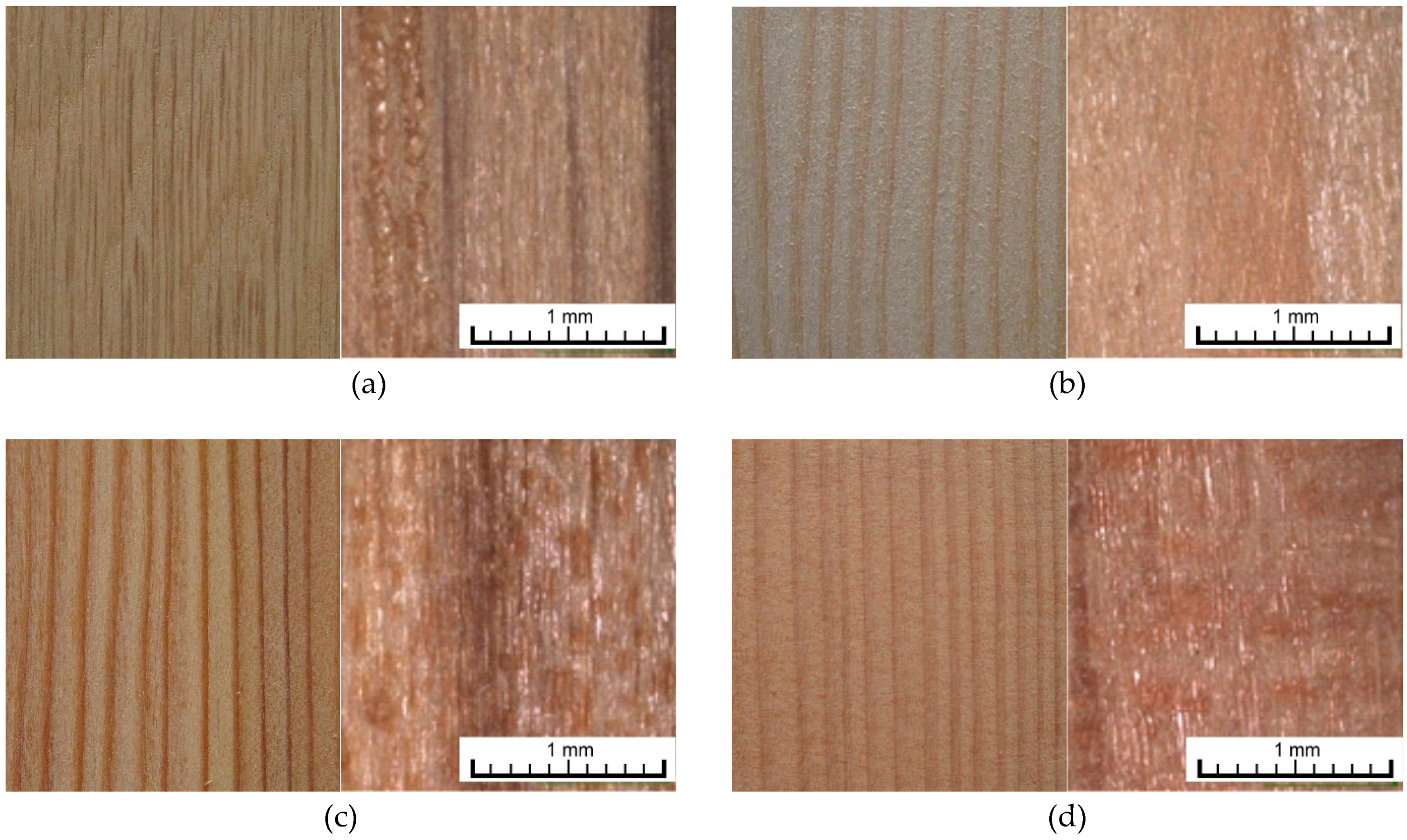
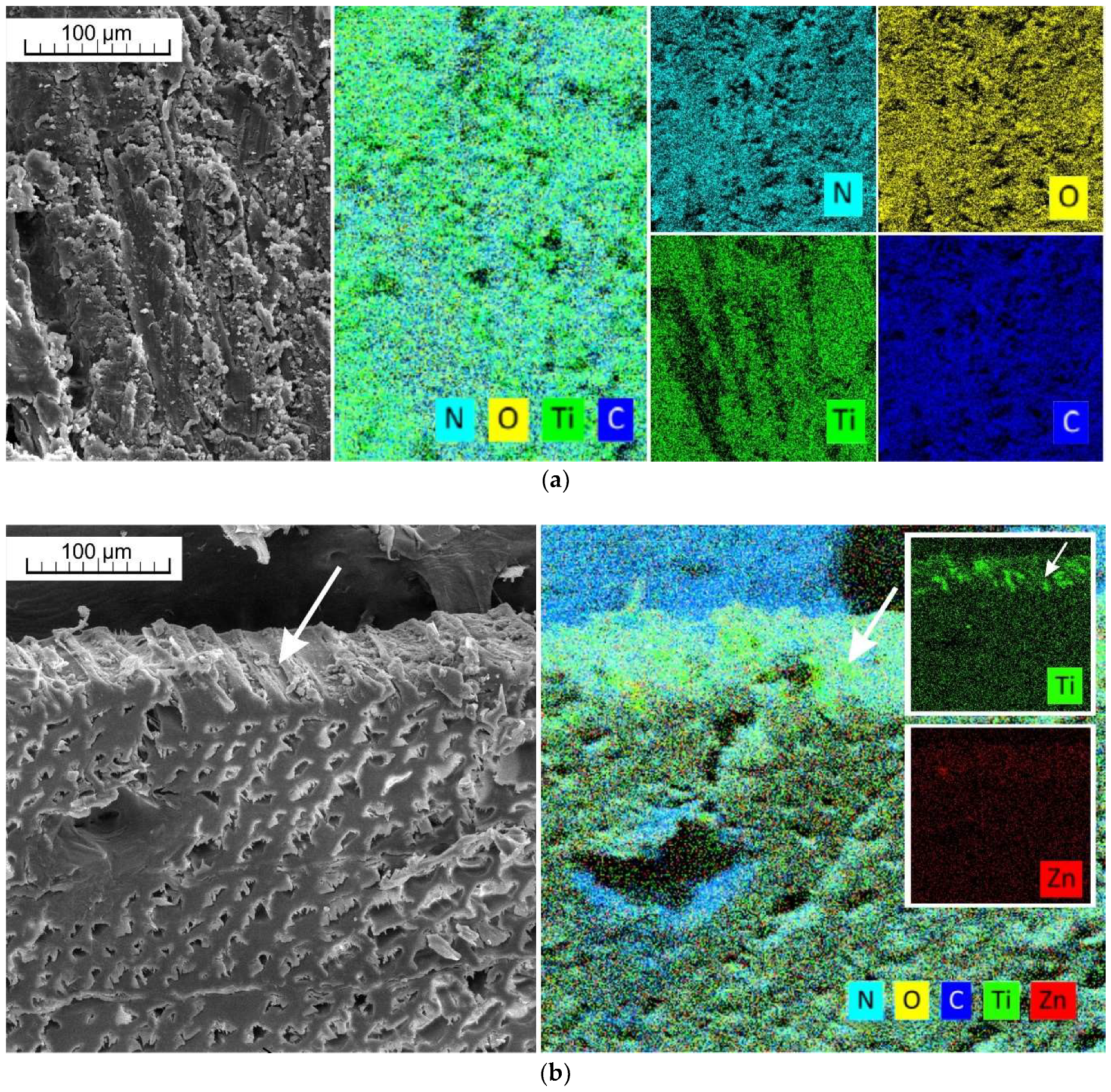
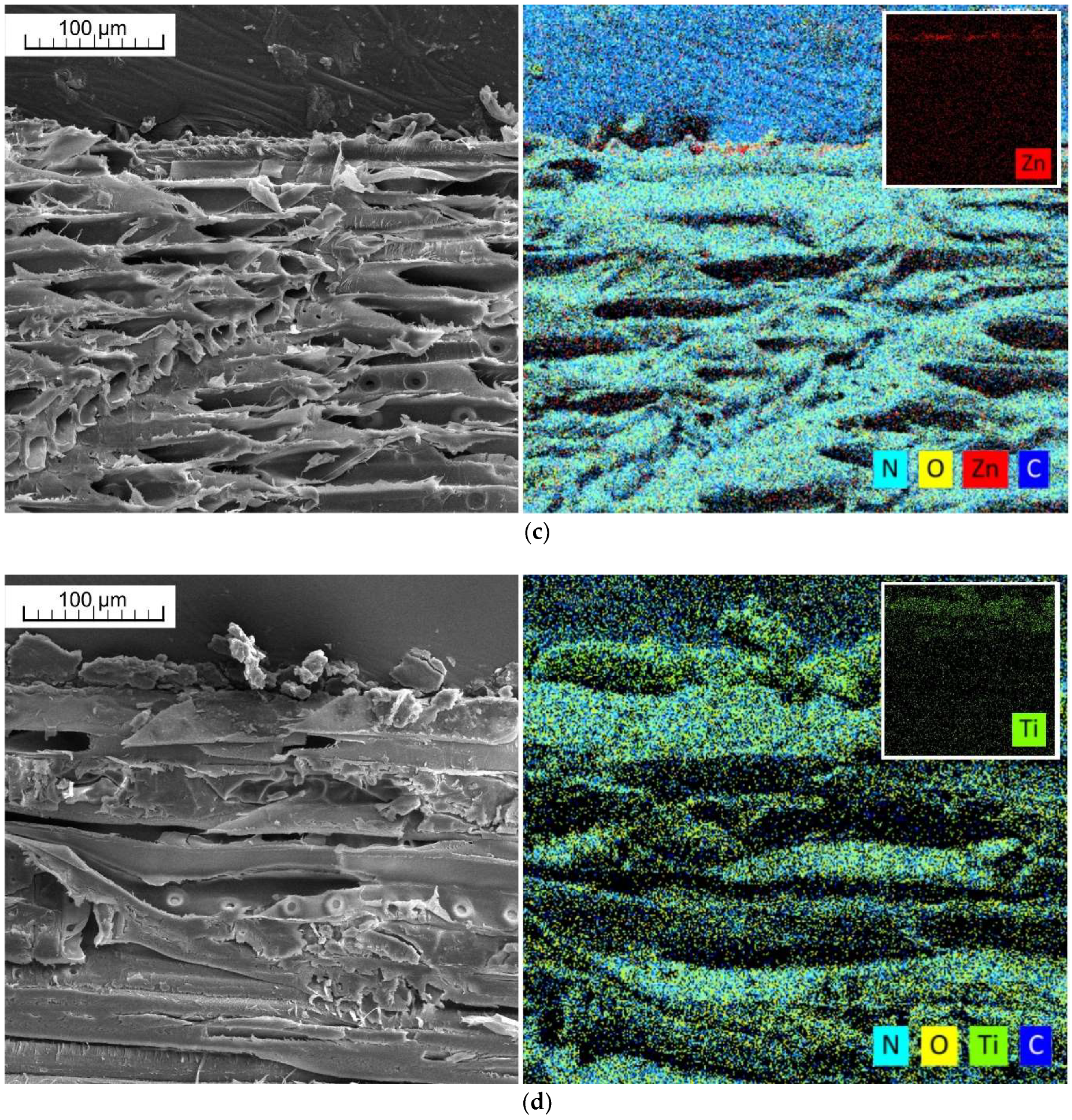
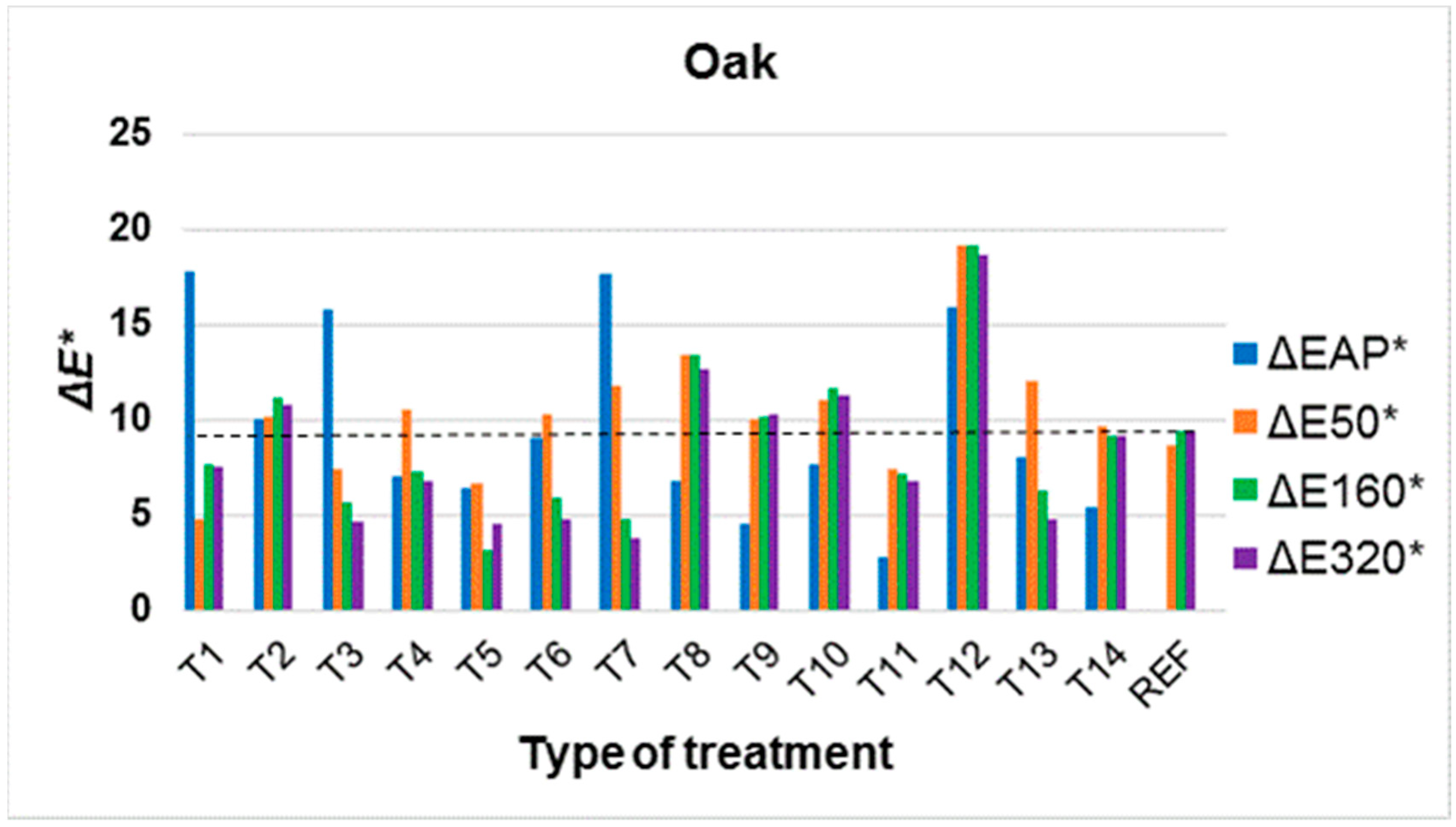


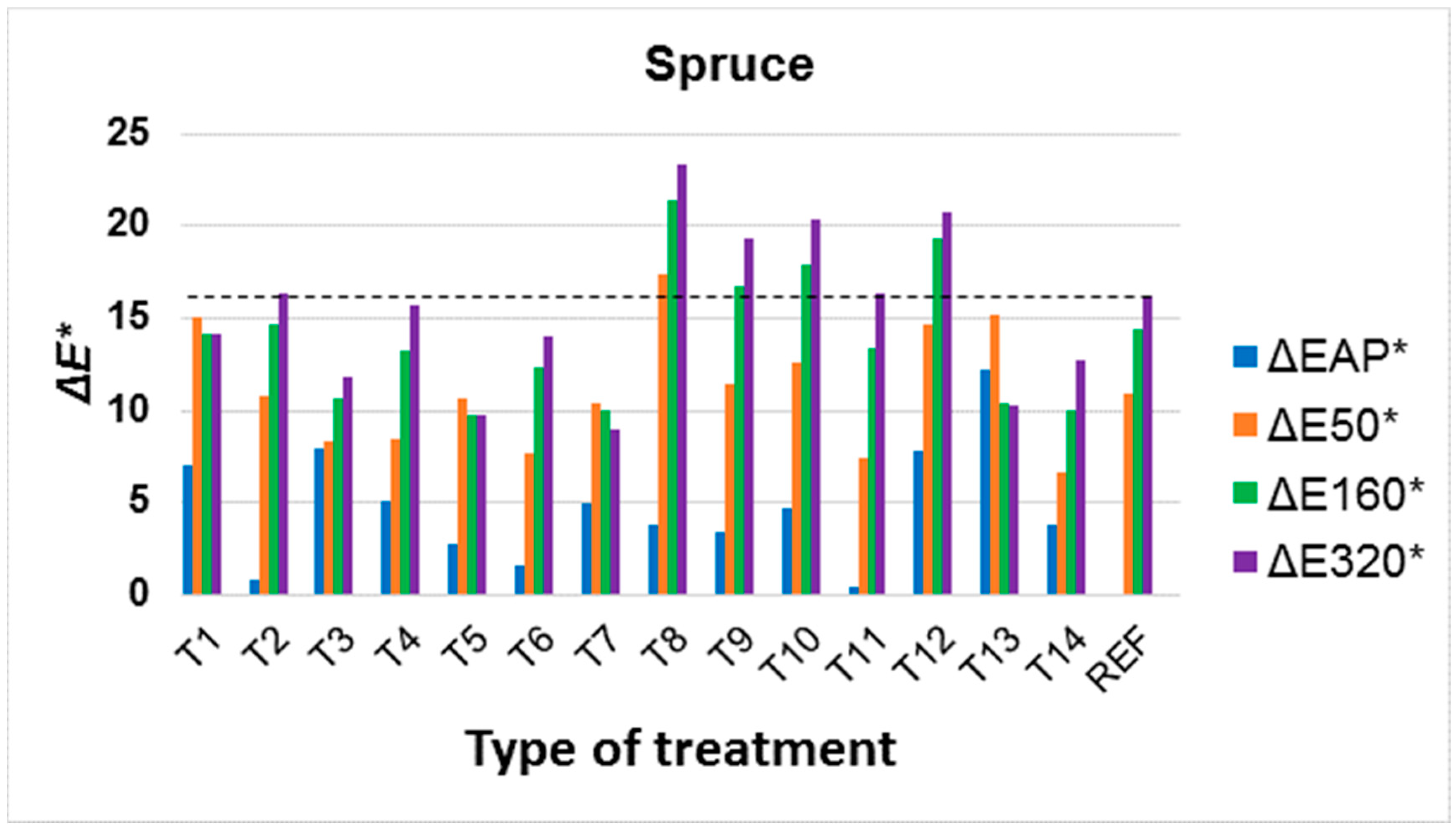
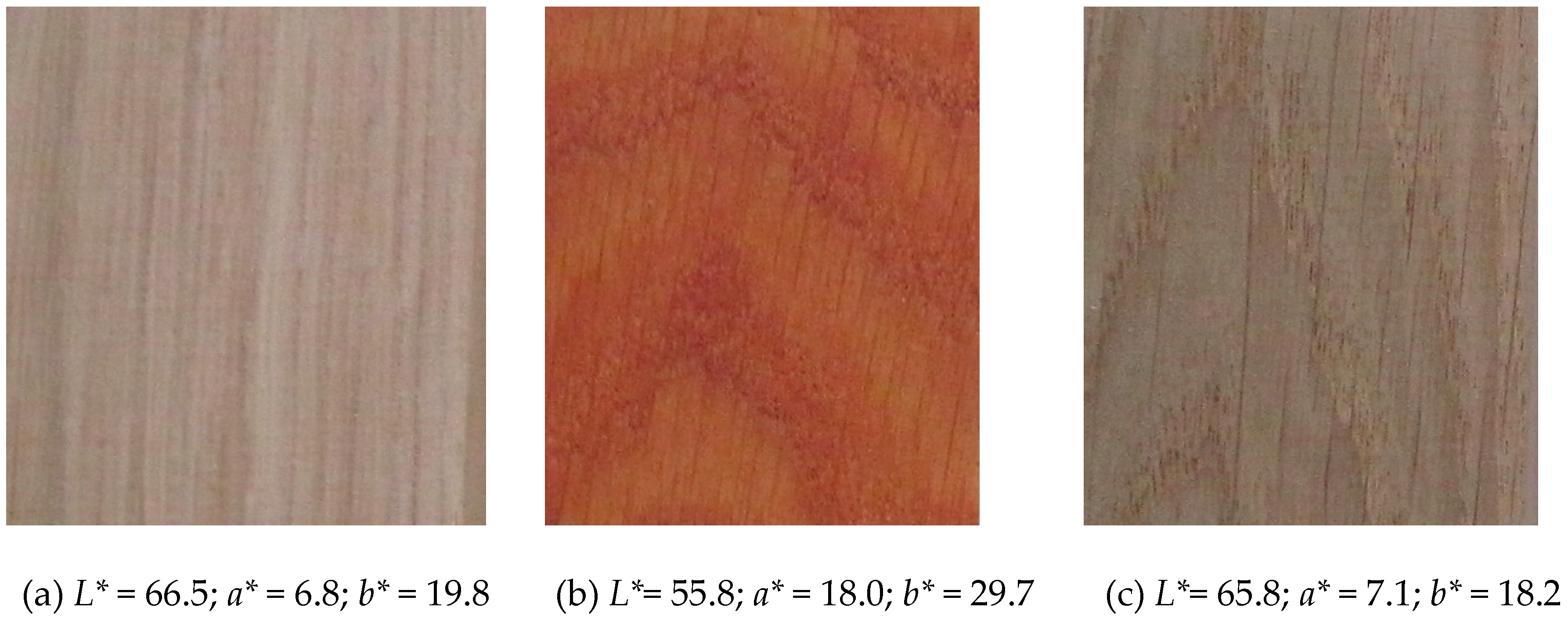

| Wood Species | Latin Name | Density (kg·m−3) at MC = 0% | L* | a* | b* |
|---|---|---|---|---|---|
| English oak | (Quercus robur L.) | 712.3 (57.0) | 66.5 (2.4) | 6.8 (0.6) | 19.8 (0.7) |
| Norway spruce | (Picea abies L. Karst) | 485.6 (26.0) | 82.5 (2.7) | 4.5 (1.2) | 21.3 (2.0) |
| European larch | (Larix decidua Mill.) | 562.1 (38.9) | 72.4 (3.2) | 8.8 (2.3) | 24.9 (2.5) |
| Douglas fir | (Pseudotsuga menziesii (Mirb.) Franco) | 598.7 (8.7) | 69.3 (1.3) | 13.0 (1.5) | 23.5 (0.6) |
| Surface Treatment | Type of Substance (Ratio) | Composition (Manufacturer) | Solvent/Dispersion Base |
|---|---|---|---|
| T1 | TiO2 | 4–8 nm nanoparticles (ROTI®nanoMETIC, Karlsruhe, Germany) | Distilled water |
| T2 | ZnO | 25 nm nanoparticles (ROTI®nanoMETIC, Karlsruhe, Germany) | Distilled water |
| T3 | ZnO + TiO2 (1:1) | Combination of T1 and T2 | Distilled water |
| T4 | Tinuvin 5151 | 2-(2-hydroxyphenyl)-benzotriazoles with HALS (BASF, Ludwigshafen, Germany) | Distilled water |
| T5 | Tinuvin 5151 + ZnO + TiO2 (1:1:1) | combination of T4 and T3 | Distilled water |
| T6 | Tinuvin 5151 + ZnO (1:1) | combination of T4 and T2 | Distilled water |
| T7 | Tinuvin 5151 + TiO2 (1:1) | combination of T4 and T1 | Distilled water |
| T8 | Tinuvin 123 | bis(2,2,6,6-tetramethyl-1-octyloxypiperidin-4-yl)-1,10-decanedioate; 1,8-bis[(2,2,6,6-tetramethyl-4-((2,2,6,6-tetr amethyl-1-octyloxypiperidin-4-yl)-decan-1,10-dioyl)piperidin-1-yl)oxy]octane (BASF, Ludwigshafen, Germany) | Solution in butyl acetate |
| T9 | Tinuvin 1130 | on the base of b-[3-(2-H-Benzotriazole-2-yl)-4-hydroxy-5-tert.butylphenyl]-propionic acidpoly (ethylene glycol) 300-ester (BASF, Ludwigshafen, Germany) | Solution in butyl acetate |
| T10 | Tinuvin 123 + Tinuvin 1130 (1:1) | Combination of T8 and T9 | Solution in butyl acetate |
| T11 | Sun Care 800 | Mixture of synthetic resins, organic UV light stabilizers, IPBC fungicide (Bohme Switzerland) | Water solution |
| T12 | Sun Care 900 | UV light stabilizers in polymer dispersion (Bohme Switzerland) | Water solution |
| T13 | Sun Care 800 + Tinuvin 5151 (3%) | Combination of T11 and added 3% of 2-(2-hydroxyphenyl)-benzotriazoles with HALS (BASF, Ludwigshafen, Germany) | Water solution and Tinuvin 5151 in distilled water |
| T14 | Sun Care 800 + ZnO + TiO2 (3%; 1:1) | T11 and added 3% of 25 nm and 4–8 nm nanoparticles | Water solution and nanoparticles in distilled water |
| REF | Reference | Without | none |
| Type of Treatment | T1 | T2 | T3 | T4 | T5 | T6 | T7 | T8 | T9 | T10 | T11 | T12 | T13 | T14 | REF | |
|---|---|---|---|---|---|---|---|---|---|---|---|---|---|---|---|---|
| Oak | ∆L* | 2.0 (2.4) | −5.1 (1.5) | −0.2 (4.8) | −1.4 (1.6) | 1.1 (2.3) | 0.0 (1.4) | 2.1 (2.6) | −7.4 (1.7) | −5.3 (1.5) | −6.2 (2.6) | −1.0 (1.2) | −11.4 (1.4) | −2.2 (0.5) | −4.5 (1.7) | −5.7 (0.5) |
| ∆a* | −1.2 (1.5) | 1.5 (0.5) | −0.4 (0.8) | 0.4 (0.4) | −1.0 (0.8) | −1.1 (0.5) | −0.6 (1.3) | 3.6 (0.7) | 2.6 (0.3) | 2.9 (1.4) | 0.1 (0.5) | 4.6 (0.4) | −2.2 (0.2) | 0.8 (0.3) | 3.1 (0.2) | |
| ∆b* | −6.8 (1.8) | 9.2 (1.4) | 1.6 (1.1) | 6.5 (1.1) | −3.4 (1.4) | 4.4 (1.0) | −1.3 (2.0) | 9.6 (0.5) | 8.4 (0.4) | 8.8 (1.6) | 6.7 (0.4) | 14.1 (0.7) | −3.7 (0.4) | 8.0 (0.5) | 6.8 (0.4) | |
| ∆E* | 7.5 (2.6) | 10.8 (0.6) | 4.7• (1.5) | 6.8• (1.0) | 4.5•S (0.7) | 4.8• (0.7) | 3.8• (1.8) | 12.7• (1.1) | 10.3 (0.9) | 11.3 (3.0) | 6.9•S (0.6) | 18.7• (1.1) | 4.8• (0.4) | 9.3 (0.9) | 9.4 (0.3) | |
| Larch | ∆L* | −1.5 (3.5) | −8.8 (1.8) | −11.8 (2.7) | −8.1 (3.0) | −5.7 (2.5) | −5.0 (1.5) | −5.5 (3.5) | −12.1 (5.5) | −10.3 (1.6) | −9.8 (2.8) | −1.4 (1.9) | −5.0 (0.6) | 4.4 (1.0) | −5.5 (1.9) | −12.0 (0.9) |
| ∆a* | −0.3 (0.9) | 2.7 (1.1) | 4.4 (1.2) | 2.9 (1.5) | 1.0 (1.4) | 1.0 (0.6) | −1.2 (2.6) | 5.0 (2.3) | 0.6 (0.7) | 4.0 (1.2) | 1.3 (0.6) | −0.2 (0.7) | −2.2 (0.7) | 0.3 (1.2) | 2.5 (0.4) | |
| ∆b* | −4.9 (2.5) | 4.8 (2.3) | 5.0 (1.1) | 7.7 (2.3) | 4.5 (3.7) | 4.8 (2.0) | −3.9 (2.8) | 12.0 (1.2) | 2.9 (1.0) | 9.9 (1.4) | 4.8 (0.8) | 7.4 (1.1) | −0.8 (1.1) | 7.4 (0.8) | 2.2 (0.5) | |
| ∆E* | 6.2•S (2.4) | 10.6 (2.4) | 13.6 (2.9) | 11.8 (3.0) | 8.3• (2.2) | 7.4•S (1.2) | 7.7•S (3.7) | 18.1• (5.1) | 10.8 (1.4) | 14.7 (1.8) | 5.4• (1.6) | 9.0 (1.1) | 5.1• (0.8) | 9.4 (1.3) | 12.5 (0.9) | |
| Douglas fir | ∆L* | −4.6 (0.3) | −6.4 (0.8) | −7.3 (1.2) | −7.5 (0.5) | −4.5 (2.4) | −6.9 (1.4) | −3.1 (1.3) | −9.6 (0.8) | −7.1 (0.6) | −9.3 (0.8) | −7.6 (0.3) | −8.1 (0.3) | −4.1 (0.3) | −2.8 (0.3) | −9.7 (0.1) |
| ∆a* | 0.8 (0.4) | −2.3 (0.3) | −3.8 (0.5) | −1.7 (0.2) | −3.6 (1.0) | −3.7 (0.6) | −3.7 (0.3) | −0.9 (0.3) | 1.6 (0.4) | −0.3 (0.3) | −2.4 (0.2) | −2.1 (0.2) | −5.8 (0.7) | −4.5 (0.1) | −0.7 (0.1) | |
| ∆b* | −5.2 (0.5) | 1.3 (1.2) | −2.7 (1.4) | 7.0 (0.3) | −1.6 (1.3) | 4.2 (0.7) | −5.6 (1.2) | 6.5 (0.4) | 5.8 (0.3) | 7.8 (0.4) | 5.0 (0.2) | 6.8 (0.2) | −1.4 (1.0) | 4.6 (0.3) | 6.7 (0.1) | |
| ∆E* | 7.0• (0.3) | 7.0•S (0.9) | 8.8• (0.6) | 10.4• (0.4) | 6.5•S (1.0) | 8.9• (1.0) | 7.5• (1.2) | 11.6 (0.8) | 9.3• (0.6) | 12.2 (0.4) | 9.4• (0.2) | 10.8 (0.2) | 7.3• (0.2) | 7.1•S (0.1) | 11.8 (0.2) | |
| Spruce | ∆L* | −12.8 (1.2) | −12.6 (0.5) | −10.4 (3.1) | −9.1 (1.7) | −8.0 (1.9) | −9.8 (1.7) | −7.6 (3.6) | −14.7 (1.6) | −11.6 (1.2) | −11.4 (0.7) | −9.2 (0.7) | −12.5 (0.4) | −9.3 (0.6) | −7.3 (1.1) | −10.7 (0.6) |
| ∆a* | 5.2 (0.7) | 5.1 (0.3) | 3.6 (1.4) | 3.3 (0.9) | 4.3 (0.9) | 3.3 (1.0) | 2.9 (2.2) | 6.9 (0.6) | 5.3 (0.4) | 5.7 (0.4) | 3.4 (0.3) | 5.0 (0.1) | 2.7 (0.5) | 2.2 (0.5) | 4.6 (0.2) | |
| ∆b* | 2.9 (2.1) | 9.2 (0.9) | 3.3 (3.4) | 12.4 (2.6) | 3.3 (1.6) | 9.5 (1.6) | 2.2 (3.7) | 16.7 (1.2) | 14.5 (0.4) | 15.9 (0.9) | 13.1 (0.8) | 15.7 (0.4) | 3.6 (1.5) | 10.2 (0.7) | 11.3 (0.7) | |
| ∆E* | 14.2 (1.8) | 16.4 (0.9) | 11.8•S (4.1) | 15.7 (3.2) | 9.8•S (2.0) | 14.1 (2.4) | 9.0•S (4.7) | 23.3• (1.9) | 19.4 (1.1) | 20.4• (1.0) | 16.4 (1.1) | 20.7• (0.5) | 10.4• (0.4) | 12.8 (1.2) | 16.2 (0.9) | |
| Categorical Factor | Sum of Squares | Degree of Freedom | Number of Squares | Fisher´s F Test | p-Value |
|---|---|---|---|---|---|
| Wood species (WS) | 3632 | 3 | 1211 | 377.1 | 0.000 * |
| Type of Treatment (TT) | 3919 | 14 | 280 | 87.2 | 0.000 * |
| WS*TT | 1844 | 42 | 44 | 13.7 | 0.000 * |
© 2018 by the authors. Licensee MDPI, Basel, Switzerland. This article is an open access article distributed under the terms and conditions of the Creative Commons Attribution (CC BY) license (http://creativecommons.org/licenses/by/4.0/).
Share and Cite
Pánek, M.; Oberhofnerová, E.; Hýsek, Š.; Šedivka, P.; Zeidler, A. Colour Stabilization of Oak, Spruce, Larch and Douglas Fir Heartwood Treated with Mixtures of Nanoparticle Dispersions and UV-Stabilizers after Exposure to UV and VIS-Radiation. Materials 2018, 11, 1653. https://doi.org/10.3390/ma11091653
Pánek M, Oberhofnerová E, Hýsek Š, Šedivka P, Zeidler A. Colour Stabilization of Oak, Spruce, Larch and Douglas Fir Heartwood Treated with Mixtures of Nanoparticle Dispersions and UV-Stabilizers after Exposure to UV and VIS-Radiation. Materials. 2018; 11(9):1653. https://doi.org/10.3390/ma11091653
Chicago/Turabian StylePánek, Miloš, Eliška Oberhofnerová, Štěpán Hýsek, Přemysl Šedivka, and Aleš Zeidler. 2018. "Colour Stabilization of Oak, Spruce, Larch and Douglas Fir Heartwood Treated with Mixtures of Nanoparticle Dispersions and UV-Stabilizers after Exposure to UV and VIS-Radiation" Materials 11, no. 9: 1653. https://doi.org/10.3390/ma11091653
APA StylePánek, M., Oberhofnerová, E., Hýsek, Š., Šedivka, P., & Zeidler, A. (2018). Colour Stabilization of Oak, Spruce, Larch and Douglas Fir Heartwood Treated with Mixtures of Nanoparticle Dispersions and UV-Stabilizers after Exposure to UV and VIS-Radiation. Materials, 11(9), 1653. https://doi.org/10.3390/ma11091653





